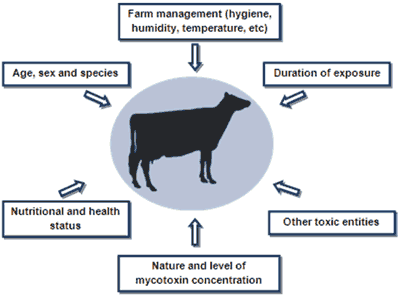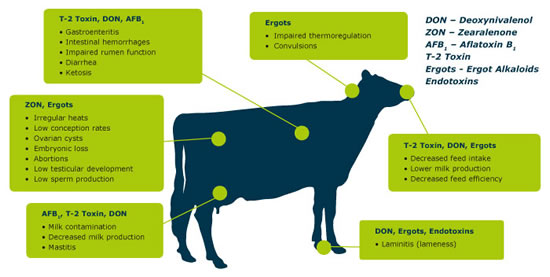
Ruminants
Symptoms/Residues
The contamination of feedstuffs with mycotoxins poses a serious threat to the health and productivity of animals.Mycotoxicoses are animal or human diseases caused by mycotoxin ingestion, inhalation or skin-contact. The effects of mycotoxicoses in animals are diverse, varying from immune suppression to death in severe cases, depending on toxin-related (type of mycotoxin consumed, level and duration of intake), animal-related (species, sex, age, breed, general health, immune status, nutritional standing) and environmental (farm management, hygiene, temperature) factors.

Mycotoxins have different effects on the various organs and in the animal productivity and health. Below a simple explanation of the terms that will be used to describe the effects of mycotoxins in animals is given:
Immunosuppression: |
when one or more functions of the immune system are suppressed, resulting in an impaired resistance to infectious agents. |
Hematopoietic Effects: |
hematopoiesis refers to the production of all types of bloods cells from the primitive cells (stem cells) in the bone marrow. The dysfunction of hematopoiesis leads firstly to the decrease of production of neutrophils (white cells that help the cell to kill and digest microorganisms engulfed by phagocytosis), thus perturbing the animals’ immune system and subsequently to the decrease of red blood cells, leading to anemia. |
Hepatotoxic Effects: |
hepatotoxicity refers to liver damage caused by toxic substances. |
Nephrotoxic Effects: |
nephrotoxicity refers to kidney damage caused by toxic substances. Nephropathy is the term used to describe kidney inflammation. |
Reproductive Effects: |
involve all the negative impacts in the reproductive system and in reproduction. |
Teratogenic Effects: |
refer to birth defects, both structural and functional, caused to the newborn. |
Neurotoxic Effects: |
when the nervous system is affected. |
Carcinogenic Effects: |
involve the promotion of cancer and of the spread of cancer cells. |
Dermal Effects: |
Dermal toxicity involves all the damage caused to the skin by toxic substances. |
Gastro-intestinal Effects: |
involve all the effects which are caused in the gastro-intestinal tract. |
Performance Effects: |
involve the changes in performance that can be detected by lower daily weight gain, poor feed conversion rates, lower production (eggs, milk) and decreased feed intake. |
Pathological Effects: |
pathology refers to the study of organs in order to examine the effects of a certain disease. Changes from the normal appearance of a certain organ are known as pathological changes. |
Residues: |
refer to the mycotoxin carry-over into blood and muscles which may and often lead to residues in animal products such as meat and eggs. |
Effects of mycotoxins on the health of ruminants

Information on the tables regarding the effects and symptoms of mycotoxins on animals was gathered from various sources. Field trials and scientific and laboratory research have been performed throughout the years leading to different discoveries and achievements in the mycotoxins field. Nevertheless, it should not be forgotten that mycotoxin contaminations are very complex in nature.
Some factors which complicate the process of dealing with mycotoxins are:
- Mycotoxins affect more than one system simultaneously, therefore producing a multiplicity of responses in the affected animals. This makes it harder to attribute the response to a single body system.
- The effects observed are not necessarily unique to a given mycotoxin but may be shared by other toxins and pathogenic organisms, making it harder to establish a cause-effect relationship for individual mycotoxins.
- Data gathered in experimental studies differ from the natural intoxications where there are many other factors (mentioned above) that can influence the disease condition. Also naturally caused mycotoxicoses are often more complex than those created in experimental studies due to the interactions between mycotoxins.
Due to these factors, it is possible that symptoms different to those presented below occur in animals. Younger animals are generally more susceptible to the toxic effects of all mycotoxins.
Mycotoxicoses in runinants

| Effects | Signs/Symptoms/Remarks | |
| Aflatoxins | Carcinogenic effects | Higher incidence of cancer in exposed animals |
| Immunosuppression | Decreased resistance to environmental and microbial stressors Increased susceptibility to diseases |
|
| Decreased performance | Decreased feed intake and milk production (dairy); weight loss and reduced weight gain (cattle) |
|
| Pathological changes | Increased liver weight and kidney weight | |
| Hepatotoxic effects | Liver damage | |
| Gastro-intestinal effects | Impaired rumen function: - Decreased cellulose digestion; - volatile fatty acid formation; - proteolysis and rumen motility Diarrhea. |
|
| Residues | Residues (aflatoxin M1) present in milk | |
| Reproductive effects | Decreased breeding efficiency Birth of smaller and unhealthy calves Acute mastitis |
| Effects | Signs/Symptoms | |
| Trichothecenes | Immunosuppression | Decreased resistance to environmental and microbial stressors Increased susceptibility to diseases |
| Decreased performance | Reduced milk production Reduced feed intake |
|
| Gastro-intestinal effects | Gastroenteritis/Inflammation of the rumen | |
| Hematopoietic effects | Hemorrhages | |
| Dermal effects | Inflammation of mouth, lesions | |
| Neurotoxic Effects | Restlessness |
| Effects | Signs/Symptoms | |
| Zearalenone | Reproductive Effects | Infertility Decreased conception rates Abortions Teat enlargement Udder secretions |
| Decreased performance | Decreased milk production |
| Effects | Signs/Symptoms | |
| Ergot Alkaloids | Neurotoxic effects | Anorexia Occasional convulsions Reduced feed intake |
| Decreased performance | Low milk production Reduced growth |
|
| Reproductive effects | Abortions Decreased pregnancy rates Decreased calving rates Weak testicular development Low sperm production |
|
| Pathological changes | Lameness Necrosis of abdominal fat Diarrhea |
| Effects | Signs/Symptoms | |
| Fescue toxins | Immune suppression | Decreased resistance to environmental and microbial stressors; increased susceptibility to diseases |
| Neurotoxic effects | Ryegrass staggers | |
| General effects | Lower weight gain Increased body temperature Rough hair coat Gangrenous necrosis of tissue in feet, tail and ears |
